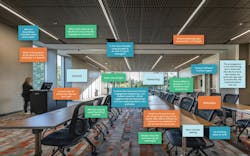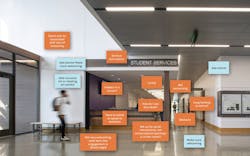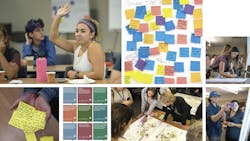Inclusive design requires relearning how we read space
It’s a simple premise: we all perceive space differently. The widely held belief that the built environment is fundamentally abstract—a neutral composition of form and material—doesn’t hold up to scrutiny. Early critiques of this idea emphasized physical accessibility, noting that mobility-challenged individuals perceive inaccessible environments as barriers to full social and personal development. In other words, tangible obstacles aroused intangible perceptions of exclusion and repression.
Similar contemporary research demonstrates that the full range of our experience—physical, social, and cultural—impacts our “reading” of the space around us. As architects and planners, it’s essential that we acknowledge this and strive to create genuinely inclusive settings.
Inclusive design workshop exercises
I recently had the opportunity to explore this issue through our SXSW EDU “Inclusive Campus Design Workshop.” With guidance from social justice educator, community organizer, and participatory action researcher Amara Perez, PhD, and student researcher Christina Avila, we led participants through an exercise to read the social messaging encoded in our campus buildings and landscapes. The imagery used ranged in complexity—from restroom signage that reinforced binary gender definition to classrooms that contributors perceived as “hierarchical” and “replicating power structures.”
Amara detailed how the engagement of historically marginalized students, faculty, and staff generates counter-narratives, or alternatives, to dominant white male narratives. In turn these counter-narratives can inform and expand inclusion in the design and materialization of our campuses.
As we prepared for the workshop, I was drawn to the idea of sharing design power and authority with those not typically involved in the process of creating buildings and landscapes. I’m convinced this is necessary to advance justice, equity, and inclusion—as well as the future of the design professions, which are always at risk of becoming instruments of the powerful. I’m looking forward to a new phase in my career where we prioritize diversity in stakeholder engagement and a broader definition of design excellence. This won’t happen automatically.
As design professionals we must:
- Guarantee the participation of historically marginalized communities through participatory design processes.
- Engage these stakeholders on their terms, in settings where they feel secure and authoritative.
- Use a broad range of engagement strategies and techniques to elicit meaningful range of perspectives.
- Respect the “test and assess” phase of design thinking by seeking and taking action on feedback gathered from these stakeholders; bring the “design crit” to them.
- Expand the pool of marginalized planners and designers and empower these voices to connect across cultures.
- Design not for ourselves—or some imagined neutral user— but for the rich diversity at the heart the American experience and culture.
We have begun to act on these principles in several of our projects, including a health sciences education project in Canada where we are engaging First Nations stakeholders in the design of their clinical environments. This allowed stakeholders to share the traumas of forced assimilation and express distrust of institutional authority. As a counter-narrative, participants shared cultural signals that would make these clinics more welcoming, including solar orientation, materiality—using stone to express both persistence and healing—and the use of First Nations motifs, like the star blanket. Our team looks forward to sharing more progress as we grow into these aspirations for inclusive design.


